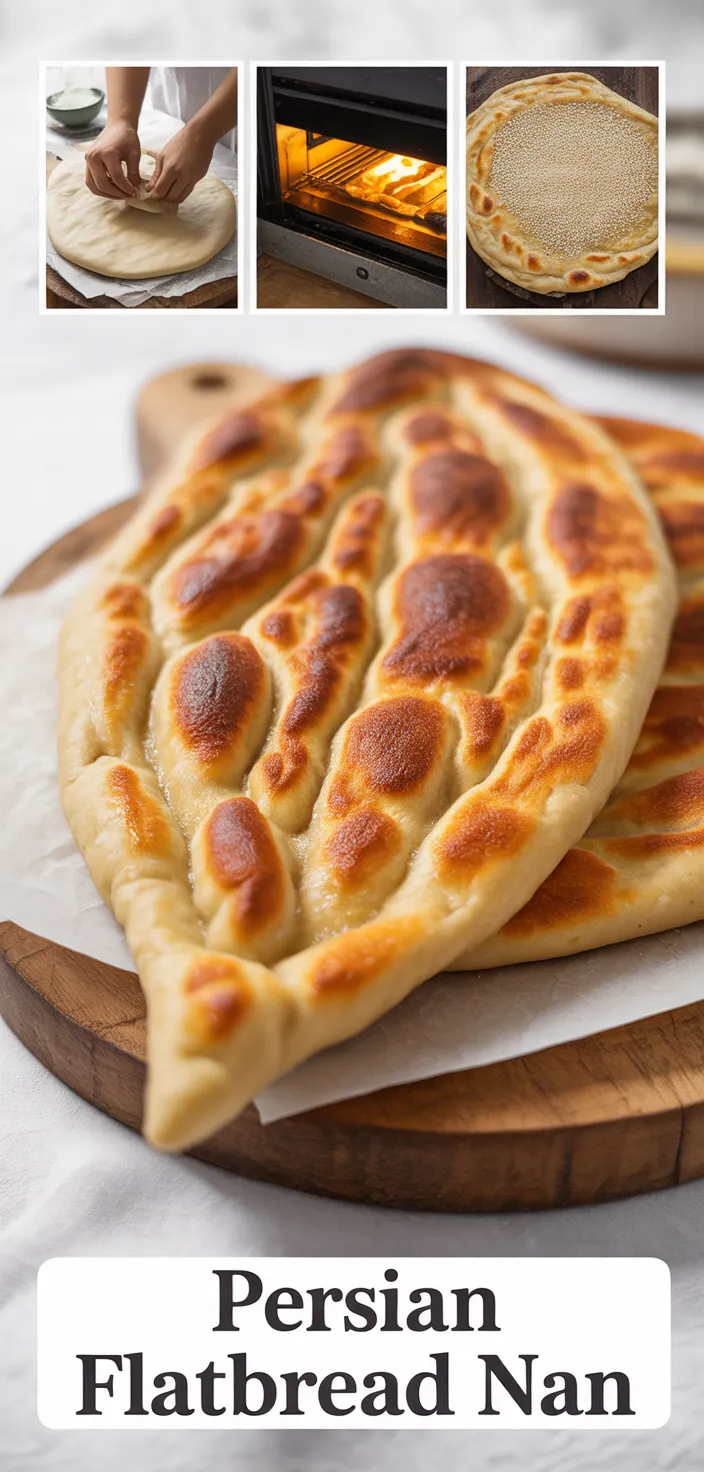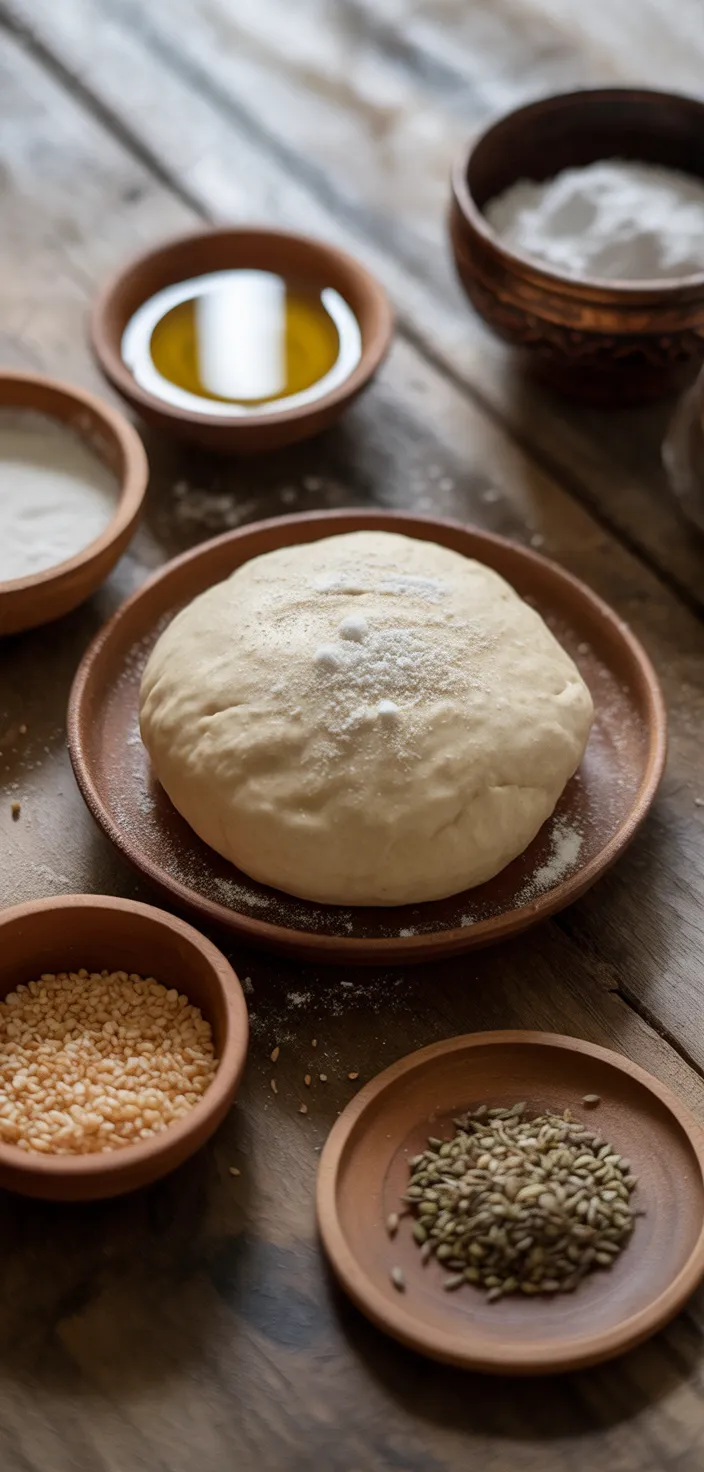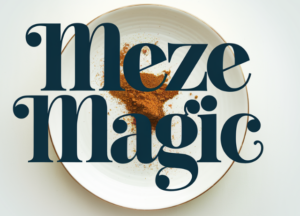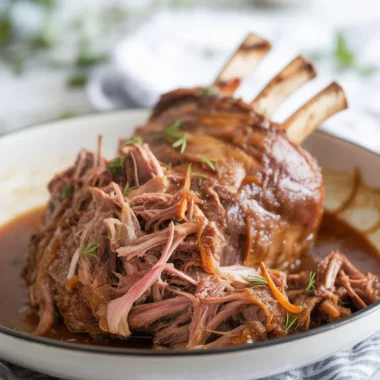I traced the centuries-old craft behind my Nan-e-Barbari recipe in this Persian Flatbread piece, and what I uncovered about its royal name will surprise you.

I first found Nan e Barbari on a trip to Tehran and couldnt stop thinking about that thick blistered crust. The name sounds so royal and making this Persian Flatbread at home felt like sneaking into a palace kitchen.
Using simple bread flour and a scatter of nigella seeds you get something crisp and chewy that keeps pulling you back. If you like an Authentic Naan Bread Recipe story, this one will surprise you; its familiar but also totally different, and it teases you into trying just one more slice.
I still mess up the oven heat sometimes, but every bake teaches me something.
Ingredients

- Bread flour: High in carbs and gluten, gives chew and structure, some protein but low fiber.
- Water: Hydrates dough, no calories, just vital for texture and yeast activity.
- Yeast: Creates air pockets, adds a slight tang, boosts B vitamins when active.
- Sugar or honey: Feeds yeast, tiny sweetness, adds colour and caramel notes to crust.
- Olive oil: Adds fat for softness and flavour, some healthy fats, richer mouthfeel.
- Sesame and nigella seeds: Crunch, nutty and oniony notes, tiny protein and minerals, great on top.
- Salt: Controls fermentation, brightens flavour, small sodium dose but essential.
- Flour glaze (roomal): Makes soft skimmed crust, gives pale sheen, sometimes adds slight chew.
Ingredient Quantities
- 500 g bread flour (about 4 cups), or all purpose flour
- 325–350 ml warm water (1 1/3 to 1 1/2 cups)
- 1 teaspoon instant yeast (or 2 1/4 teaspoons active dry yeast, 1 packet)
- 1 tablespoon sugar or honey
- 1 1/2 teaspoons fine salt
- 2 tablespoons olive oil, plus extra for the pan
- For the flour glaze (roomal): 3 tablespoons all purpose flour
- 1/2 cup water for the glaze
- 1/4 teaspoon baking soda (or 1/2 teaspoon baking powder), optional
- 2 tablespoons sesame seeds
- 1 tablespoon nigella seeds (black caraway, kala jeera)
- Coarse or kosher salt for sprinkling
- 1 egg yolk + 1 tablespoon milk, optional egg wash for color
How to Make this
1. Pour 325 to 350 ml warm water into a bowl, stir in 1 tablespoon sugar or honey and 1 teaspoon instant yeast (if using active dry yeast, use 2 1/4 teaspoons and let sit 5 to 10 minutes until foamy); add 2 tablespoons olive oil and set aside.
2. In a large bowl mix 500 g bread flour (or all purpose) with 1 1/2 teaspoons fine salt, make a well and pour in the yeast mixture, stir until a shaggy dough forms.
3. Knead by hand 8 to 10 minutes or in a mixer 5 to 7 minutes until dough is smooth and slightly tacky; coat the dough with a little olive oil, place in a bowl, cover and let rise 1 to
1.5 hours until doubled.
4. While dough proofs make the flour glaze (roomal): whisk 3 tablespoons all purpose flour with 1/2 cup water until lump free, cook over medium heat stirring constantly until it thickens to a gluey paste, remove from heat and if you want add 1/4 teaspoon baking soda (or 1/2 teaspoon baking powder); let cool to warm.
5. Punch down the dough, divide into 2 (for big loaves) or 3 pieces, shape each into a tight ball and rest 10 to 15 minutes covered so gluten relaxes.
6. Preheat your oven as high as it goes (about 250 to 275 C / 475 to 525 F) with a baking stone or an inverted heavy baking sheet inside; if you don’t have a stone, oil a rimmed sheet lightly.
7. On lightly oiled parchment or a floured surface pat each ball into a long oval about 1 to 1 1/2 cm thick; use your fingertips or knuckles to make 3 to 4 long shallow grooves along the length — that classic look, don’t press all the way through.
8. Generously brush the top of each loaf with the roomal glaze, then sprinkle 2 tablespoons sesame seeds, 1 tablespoon nigella seeds and a pinch of coarse or kosher salt. If you want extra color mix 1 egg yolk with 1 tablespoon milk and very lightly brush on top before sprinkling seeds so they stick.
9. Slide the loaves onto the hot stone or preheated sheet and bake 10 to 15 minutes until deep golden, edges crisp and bottom sounds hollow when tapped; rotate once for even browning and keep an eye after 8 minutes cause ovens vary.
10. Cool on a rack a few minutes, serve warm torn or sliced; store leftovers wrapped in a linen bag or re-crisp in a hot oven for a few minutes.
Equipment Needed
1. Kitchen scale or measuring cups and spoons (scale is best for 500 g flour)
2. Large mixing bowl for the dough
3. Small bowl or cup for proofing yeast and mixing the oil mixture
4. Whisk for the flour glaze and measuring out liquids
5. Small saucepan to cook the roomal glaze
6. Wooden spoon or silicone spatula for stirring and scraping
7. Bench scraper or sharp knife to divide and shape the dough
8. Pastry brush to apply the glaze and optional egg wash
9. Baking stone or an inverted heavy rimmed baking sheet plus parchment paper
10. Cooling rack and oven mitts for handling hot loaves
FAQ
Persian Flatbread Nan Recipe Substitutions and Variations
- Bread flour (500 g): swap 1) all purpose flour plus 1 to 2 teaspoons vital wheat gluten per cup to keep the chew, 2) whole wheat flour for a nuttier loaf but add about 25–50 ml more water and knead longer, 3) a 1:1 gluten free flour blend designed for yeast breads plus 1 teaspoon xanthan gum, expect a different texture and slightly more hydration and handling. Tip: if dough feels too soft, add flour a tablespoon at a time, dont overdo it.
- Instant yeast (1 tsp): swap 1) active dry yeast, use 2 1/4 teaspoons and proof it in warm water for 5–10 minutes first, 2) fresh compressed yeast, roughly 3 times the weight of instant yeast, crumble and dissolve, 3) active sourdough starter, about 150–200 g, reduce water by ~50–75 ml and allow much longer rises for tangy flavor.
- Olive oil (2 tbsp): swap 1) melted butter for richer flavor and better browning, 2) neutral oils like canola or sunflower if you dont want olive taste, 3) 1 to 2 tablespoons plain yogurt or labneh (reduce water slightly) for a softer crumb and a touch of tang.
- Sesame seeds + nigella: swap 1) poppy seeds or toasted flax seeds for a different nuttiness, 2) lightly crushed cumin or fennel seeds for a warm savory note, 3) zaatar or crushed dried herbs, or just coarse sea salt with a brush of oil for crunch and shine if you cant find nigella.
Pro Tips
– Get the yeast and water right, not perfect measurements, just the feel. Use water that’s warm to the touch but not hot, stir in the sugar or honey to wake the yeast, and if the yeast doesnt bubble after a few minutes toss it and start again. Humidity and flour vary, so add a splash more water if the dough feels stiff, or a dusting of flour if it feels soupy.
– Learn the windowpane test, it’s worth the 10 extra seconds. When you can stretch a bit of dough thin enough to see light through it without tearing, you know gluten’s developed. If it’s still tearing, knead a little more, but don’t overdo it or the crumb will be tight.
– Make the glaze just like a glue, cook till smooth then cool to warm before you brush. If it’s too hot the seeds will slide off, too cool and it wont spread well. Press the seeds into the surface with your fingers if they wont stick, and if you want extra color use a very light egg wash just before seeds so you dont wash off the roomal.
– Heat the baking surface until it’s screaming hot, that initial blast of heat makes the crust crisp and bitey. Add a quick shot of steam at the start (a small pan of boiling water or a fast spray) to get better oven spring, rotate once for even color, and cool the loaves a few minutes before slicing so the crumb sets. Store in a linen bag or revive leftovers in a hot oven for a few minutes, dont seal in plastic unless you want it soft and sad.
Persian Flatbread Nan Recipe
My favorite Persian Flatbread Nan Recipe
Equipment Needed:
1. Kitchen scale or measuring cups and spoons (scale is best for 500 g flour)
2. Large mixing bowl for the dough
3. Small bowl or cup for proofing yeast and mixing the oil mixture
4. Whisk for the flour glaze and measuring out liquids
5. Small saucepan to cook the roomal glaze
6. Wooden spoon or silicone spatula for stirring and scraping
7. Bench scraper or sharp knife to divide and shape the dough
8. Pastry brush to apply the glaze and optional egg wash
9. Baking stone or an inverted heavy rimmed baking sheet plus parchment paper
10. Cooling rack and oven mitts for handling hot loaves
Ingredients:
- 500 g bread flour (about 4 cups), or all purpose flour
- 325–350 ml warm water (1 1/3 to 1 1/2 cups)
- 1 teaspoon instant yeast (or 2 1/4 teaspoons active dry yeast, 1 packet)
- 1 tablespoon sugar or honey
- 1 1/2 teaspoons fine salt
- 2 tablespoons olive oil, plus extra for the pan
- For the flour glaze (roomal): 3 tablespoons all purpose flour
- 1/2 cup water for the glaze
- 1/4 teaspoon baking soda (or 1/2 teaspoon baking powder), optional
- 2 tablespoons sesame seeds
- 1 tablespoon nigella seeds (black caraway, kala jeera)
- Coarse or kosher salt for sprinkling
- 1 egg yolk + 1 tablespoon milk, optional egg wash for color
Instructions:
1. Pour 325 to 350 ml warm water into a bowl, stir in 1 tablespoon sugar or honey and 1 teaspoon instant yeast (if using active dry yeast, use 2 1/4 teaspoons and let sit 5 to 10 minutes until foamy); add 2 tablespoons olive oil and set aside.
2. In a large bowl mix 500 g bread flour (or all purpose) with 1 1/2 teaspoons fine salt, make a well and pour in the yeast mixture, stir until a shaggy dough forms.
3. Knead by hand 8 to 10 minutes or in a mixer 5 to 7 minutes until dough is smooth and slightly tacky; coat the dough with a little olive oil, place in a bowl, cover and let rise 1 to
1.5 hours until doubled.
4. While dough proofs make the flour glaze (roomal): whisk 3 tablespoons all purpose flour with 1/2 cup water until lump free, cook over medium heat stirring constantly until it thickens to a gluey paste, remove from heat and if you want add 1/4 teaspoon baking soda (or 1/2 teaspoon baking powder); let cool to warm.
5. Punch down the dough, divide into 2 (for big loaves) or 3 pieces, shape each into a tight ball and rest 10 to 15 minutes covered so gluten relaxes.
6. Preheat your oven as high as it goes (about 250 to 275 C / 475 to 525 F) with a baking stone or an inverted heavy baking sheet inside; if you don’t have a stone, oil a rimmed sheet lightly.
7. On lightly oiled parchment or a floured surface pat each ball into a long oval about 1 to 1 1/2 cm thick; use your fingertips or knuckles to make 3 to 4 long shallow grooves along the length — that classic look, don’t press all the way through.
8. Generously brush the top of each loaf with the roomal glaze, then sprinkle 2 tablespoons sesame seeds, 1 tablespoon nigella seeds and a pinch of coarse or kosher salt. If you want extra color mix 1 egg yolk with 1 tablespoon milk and very lightly brush on top before sprinkling seeds so they stick.
9. Slide the loaves onto the hot stone or preheated sheet and bake 10 to 15 minutes until deep golden, edges crisp and bottom sounds hollow when tapped; rotate once for even browning and keep an eye after 8 minutes cause ovens vary.
10. Cool on a rack a few minutes, serve warm torn or sliced; store leftovers wrapped in a linen bag or re-crisp in a hot oven for a few minutes.















